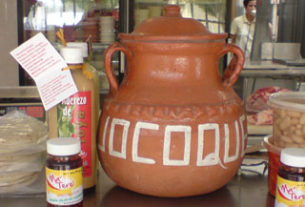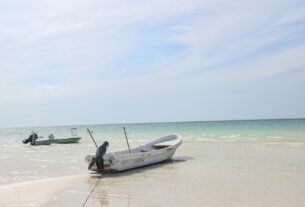Did You Know…?
The Vanilla Festival is held in early summer every year in Papantla, Veracruz. The origins of the festival pre-date the Spanish conquest. Its timing is now tied to the Catholic celebration of the Feast of Corpus Christi (Body of Christ), sixty days after Easter.
Papantla is the heart of Mexico’s vanilla-growing region. Vanilla, surely one of the world’s best known flavors, if only on account of its ubiquitous use in ice-cream, comes from the seed pods of an orchid. The pods are about 20 centimeters in length and green when harvested. After careful and laborious drying and “sweating”, these pods turn black. This caused Nahuatl-speaking Indians to name the plant tlilxóchitl (= black flower).
The orchid involved, Vanilla planifolia, grows as a thin vine twisting its way around host trees. The plant has delicate greenish-white flowers in Spring. If these flowers are not pollinated, they fall off the vine within hours. Flowers that are successfully pollinated (usually by bees) turn into seed pods, which take up to six months to ripen. For commercial cultivation, hand pollination of each individual flower is essential. Until about fifty years ago, traditional growers of vanilla in the Papantla region relied on young maidens using small sticks or feathers to perform this task. Like so many other traditions, this one has long since died out!
In the local Totonac language, vanilla is known as xanath, and this is also the name used for a liquor made from extract of vanilla and rarely seen outside the environs of Papantla and Gutiérrez Zamora, in northern Veracruz. Natural vanilla pods are also used to model baskets and even small animals, such as scorpions. The Totonacs have used vanilla for hundreds of years, both as a perfume and to add a subtle flavor to hot chocolate. Vanilla is also reputed to have various medicinal uses.
The early Spanish explorers were quick to appreciate the flavor of vanilla, and European demand for vanilla pods rose so much that some vanilla cultivators became suitably wealthy (see Vanilla: a Mexican native regains its reputation by Karen Hursh Graber).
Mexico maintained a monopoly on vanilla trade until the second half of the nineteenth century. Several attempts to grow vanilla elsewhere (eg. by Spain in the Philippines in 1819) had failed prior to the Dutch trying it on the island of Java in 1846. The French made several efforts to produce vanilla in their Indian Ocean territories and were eventually successful with the hand pollination of vanilla on the island of Réunion in 1841.
By the 1890s, vanilla growing had spread to Madagascar and the Comoros islands. Madagascar soon became the main source of the world’s vanilla. In the early 1970s, the nation’s 40,000 vanilla growers supplied 75% of the world’s vanilla, and over-produced to the point where the government felt forced to destroy its “vanilla mountain” stockpile in the 1990s in order to keep prices high.
The world’s leading producers in recent years have been Indonesia (2000 metric tons) and China (400 metric tons), followed by Tonga, Uganda and Comoros. Mexican production has fallen to a paltry 360 metric tons a year. Incidentally, vanilla is the only orchid to have been successfully cultivated on a commercial scale.
Even though Mexico gave vanilla to the world, it is still much easier in Mexico to find synthetic vanilla flavoring, “vanillin”, derived from pine resin and cloves than the real thing.
And, just how do you tell if what you are offered is the real McCoy? One clue is color. Real vanilla is neither clear, nor dark and murky, but amber-colored. What price is it? Real vanilla is always expensive, so if you paid only a few dollars for a medium-sized bottle, you can be pretty sure you bought artificial vanilla. If you happen to be traveling in Veracruz, stop in Papantla or Gutiérrez Zamora and look for a brand like Orlando Gaya Hijos.
The Vanilla Festival invariably includes the Dance of the Voladores (Flyers). This is definitely one of the more extreme dances you will ever witness, something like multiple bungee jumping and maypole dancing being performed simultaneously! Follow this link for a photo-essay on the Voladores.
The Vanilla Festival is a great place to see other folkloric dances, such as the quetzales (see previous article about Cuetzalan) and the dance of Los Negritos, in their original setting as well. Needless to say, besides the dancing, the festival has all the usual fun, stalls, and souvenirs – and even lots of genuine vanilla extract and vanilla pods, some of the latter woven into handicrafts…
Papantla is very close to the fabulous archaeological site of El Tajín, with its famous pyramid of the niches and other wonders. Hotels are available in Papantla, Poza Rica (an oil town) and in Tecolutla, a small, relaxed beach town on the Gulf.
Text © Copyright 2005 by Tony Burton. All rights reserved.


